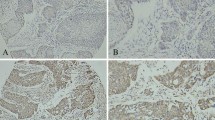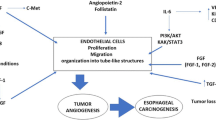Abstract
Background
Vascular endothelial growth factor C (VEGF-C) is the only factor known to cause lymphangiogenesis. In esophageal cancer the histologic tumor type and lymph node metastasis are independent predictors of recurrence and poor outcome. To evaluate the rule of VEGF-C expression in esophageal cancer, we investigated 113 specimens, 59 squamous cell and 54 adenocarcinomas of the esophagus.
Methods
The expression of VEGF-C was evaluated using immunohistochemistry (IHC) on 59 paraffin-embedded archival specimens from patients with squamous cell esophageal carcinomas and 54 paraffin-embedded archival specimens of patients with esophageal adenocarcinomas arising in Barrett’s mucosa. All patients had a complete tumor resection. A complete and updated follow-up was available for all patients.
Results
The expression of VEGF-C was significantly different between the two histological types of esophageal tumors. Patients with squamous cell carcinoma and lymph node metastases had a significantly higher VEGF-C expression (P < 0.01). In patients with adenocarcinoma of the esophagus there was no correlation between VEGF-C expression and clinicopathological parameters. High VEGF-C expression tended to be correlated with poor survival in squamous cell cancer but not in adenocarcinoma of the esophagus.
Conclusions
The present study indicates that VEGF-C may play a role in tumor progression via lymphangiogenesis in squamous cell carcinoma of the esophagus. This seems not to be true for the adenocarcinoma of the esophagus. These data could help with the understanding of the different onset and characteristics of lymph node metastasis in squamous cell carcinoma and adenocarcinoma of the esophagus.
Similar content being viewed by others
References
Siewert JR, Feith M, Werner M, et al. Adenocarcinoma of the esophagogastric junction. Results of surgical therapy based on anatomical/topographic classification in 1,002 consecutive patients. Ann Surg 2000;232:353–361
Siewert JR, Stein HJ, Feith M, et al. Histologic tumour type is an independent prognostic parameter in esophageal cancer: lessons from more than 1,000 consecutive resections at a single center in the Western world. Ann Surg 2001;234:360–369
Natsugoe S, Stein HJ, Mueller J, et al. Micrometastasis and tumor cell microinvolvement of lymph nodes esophageal squamous cell cancer: frequency, associated tumor characteristics and impact on prognosis. Cancer 1998;83:858–866
Mueller JD, Stein HJ, Oyang T, et al. Frequency and clinical impact of lymph node micrometastasis and tumor cell microinvolvement in patients with adenocarcinoma of the esophagogastric junction. Cancer 2000;89:1874–1882
Ferrara N. Molecular and biological properties of vascular endothelial growth factor. Mol Med 1999;77:527–543
Karkkainen MJ, Petrova TV. Vascular endothelial growth factor receptors in the regulation of angiogenesis and lymphangiogenesis. Oncogene 2000;19:5598–5605
Yonemura Y, Fushida S, Bando E, et al. Lymphangiogenesis and the vascular endothelial growth factor receptor (VEGFR)–3 in gastric cancer. Eur J Cancer 2001;37:918–923
Kajita T, Ohta Y, Kinura K, et al. The expression of vascular endothelial growth factor C and its receptors in non-small cell lung cancer. Br J Cancer 2001;85:255–260
Wittekind C, Compton CC, Greene FL, et al. TNM residual tumor classification revisited. Cancer 2002;94:2511–2516
Karpanem T, Egeblad M, Karkkainen J, et al. Vascular endothelial growth factor C promotes tumour lymphangiogenesis and intralymphatic tumour growth. Cancer Res 2001;61:1786–1790
Kukk E, Lymboussaki A, Taira S, et al. VEGF-C receptor binding and pattern of expression with VEGFR-3 suggests a role in the lymphatic vascular development. Development (Camb) 1996;122:3829–3837
Kitadai Y, Amioka T, Haruma K, et al. Clinicopathological significance of vascular endothelial growth factor (VEGF)- C in human esophageal squamous cell carcinomas. Int J Cancer 2001;93:662–666
Noguchi T, Takeno S, Shibata T, et al. VEGF-C expression correlates with histological differentiation and metastasis in squamous cell carcinoma of the esophagus. Oncol Rep 2002;9:995–999
Author information
Authors and Affiliations
Corresponding author
Rights and permissions
About this article
Cite this article
Möbius, C., Freire, J., Becker, I. et al. VEGF-C Expression in Squamous Cell Carcinoma and Adenocarcinoma of the Esophagus. World J Surg 31, 1768–1772 (2007). https://doi.org/10.1007/s00268-006-0373-1
Published:
Issue Date:
DOI: https://doi.org/10.1007/s00268-006-0373-1




